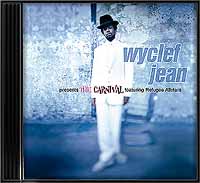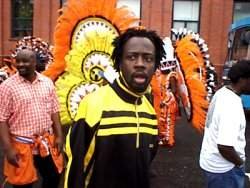World
Literature in English, 1998
Carnival by Wyclef Jean
Wyclef Jean -- the "hip-hop
Amadeus" and member of the multi-platinum recording group the Fugees --
has drawn from an extraordinarily wide
musical palette in assembling The Carnival. A kaleidoscopic journey
through Wyclef Jean's eclectic musical interests, the album features:
hip-hop appropriations of classic disco ("We Trying To Stay Alive,"
the
album's first single); an internationally-recognizable traditional
song
transformed into a hip-hop anthem ("Guantanamera"); cutting edge
rapping and scratching; four selections in French/Creole ("Sang Fezi,"
"Jaspora," "Yel," and the calypso-flavored "Carnival" -- each has
been a chart-topping hit in Wyclef's native Haiti); and a non-stop
fresh
blend of far-flung musical influences and streetwise poetry.
|
 |
While Wyclef is the primary writer, producer, and performer of The
Carnival, he's enlisted a wide range of international talent to help
him
realize his musical vision: the Refugee Allstars (Lauryn Hill, Prakazrel,
John Forte, and Melky Sedeck); the Latin superdiva Celia Cruz (on
"Guantanamera"); New Orleans musical legends the Neville Brothers
(on "Mona Lisa"); members of the New York Philharmonic Orchestra
(conducted by Wyclef on "Gone 'Til November"); the legendary I
Threes (on "Gunpowder"); and more.from (text and picturesWyclef's
web site) |
 |
Led by Wyclef, the Fugees returned to the group's Haitian motherland
to present an historic concert at the Bicentenaire in Port-au-Prince on
April 12. An estimated 80,000 fans gathered to celebrate the group's "homecoming"
and the music and art of Haiti in an atmosphere of extraordinarily good
vibes and peaceful revelry.
Tracks: Lyrics from the
Hip-Hop Lyrics Archive
Rap: Definition
To the untrained ear, all rap and hip-hop may sound the same, but there's
a number of different
levels in even the simplest rap song.
At its core, hip-hop is a post-modern musical genre that deconstructs
familiar sounds and songs, rebuilding them as entirely new, unpredictable
songs. Early rap records, commonly called "old school," were made
by DJs scratching records and playing drum loops, with MCs rapping
over the resulting rhythms.
As the genre progressed, hard-rock guitars and hard-hitting
beats were introduced by Run-D.M.C., the first hardcore rap group,
and the scratching techniques were replaced by sampling. With their
dense collages of samples, beats and white noise, Public Enemy took sampling
to the extreme, and they helped introduce a social and political
conscience to hip-hop. That faded in the '90s, as gangsta
rap -- originally introduced by NWA, who used Public Enemy's
sound as a template -- became the dominant form. By the '90s, gangsta
rap, which originally was in direct opposition to such pop-oriented rappers
as MC Hammer, had become smoothed over and stylish, and consequently
was more popular than ever, as evidenced by the success of pop-gangsta
Puff Daddy. (Rap
from All Music Guide, go there
for major types, major artists and albums)

